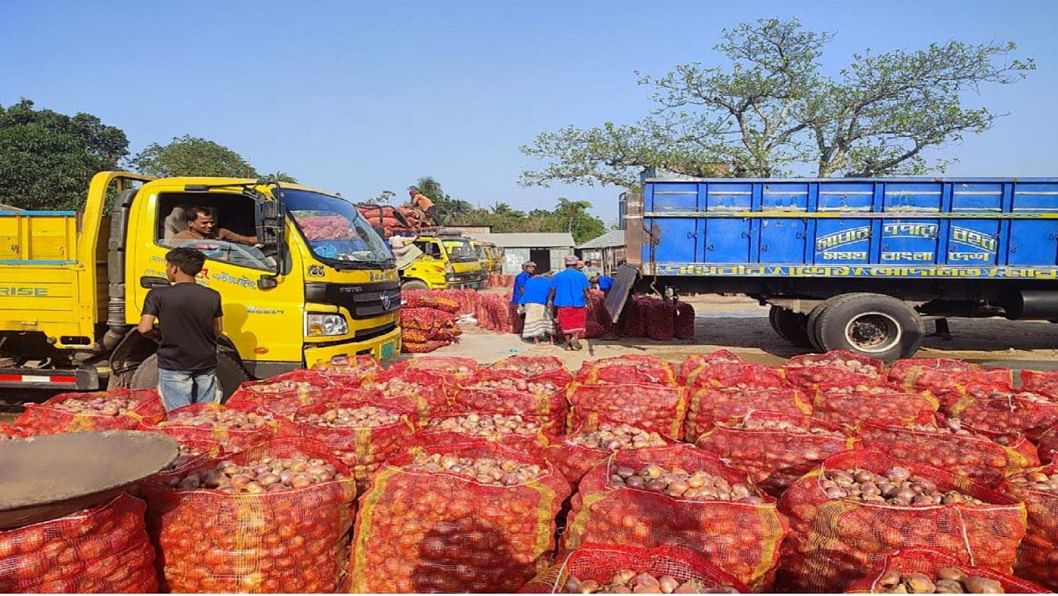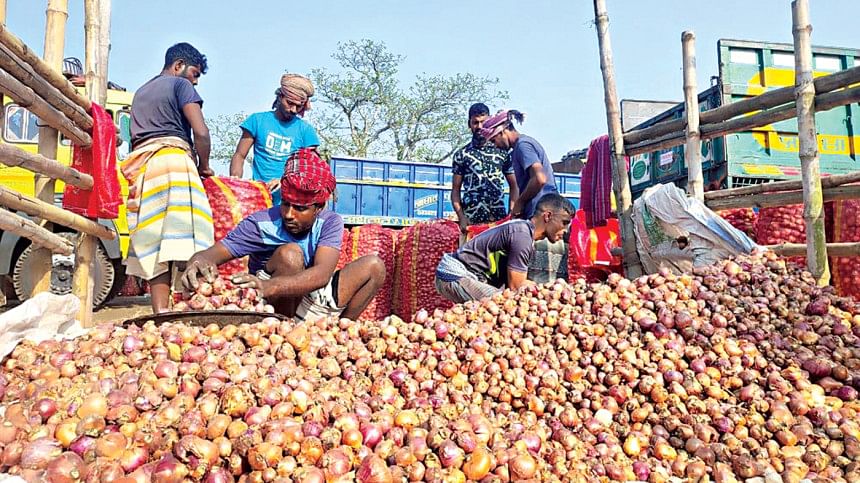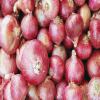New onions bring no smiles to farmers

Onion farmers, who saw high profits last year, are now struggling due to a sharp drop in prices at the peak of the harvesting season.
With new onions entering markets, prices continue to decline, raising concerns over recovering production costs in major producing regions such as Pabna and greater Faridpur.
Md Rabiul Islam, a trader at the Pushpopara wholesale market in Pabna Sadar upazila, said prices have fallen drastically.
"Each maund (around 40 kilogrammes) was fetching Tk 1,400 to Tk 1,500 last week. By Monday, it dropped to Tk 1,200 to Tk 1,300, and on Thursday, it fell further to Tk 800 to Tk 1,100," he said.
The supply of new onions has surged in the district's wholesale markets, but demand remains weak.
At Pushpopara market, around 80-100 tonnes of onions were available last Monday, rising to over 200 tonnes by Thursday. Given the weak demand, supply is expected to increase further in the coming weeks.
Md Kamruzzaman, a farmer from Durgapur village in Sujanagar upazila, said he sold onions for Tk 2,500 to Tk 3,000 per maund last year but is getting less than half that this year.
"This year, I was getting Tk 1,200 to Tk 1,300 per maund last week. The price is so low that I have stopped selling onions for now," he said.
Kamruzzaman cultivated onions on 80 bighas (one bigha = 33 decimals) this year, including 30 bighas of leased land, contributing to higher production costs.
"It costs Tk 25,000 to Tk 30,000 to cultivate one bigha of onions on owned land, but on leased land, the cost exceeds Tk 50,000 due to lease payments," he said.
His estimated production cost is over Tk 40 per kg, making it difficult to break even at current prices.

However, Md Ashikur Rahman, deputy assistant agriculture officer of the Department of Agricultural Extension (DAE) in Pabna, said that after factoring in high seed prices, fertiliser costs, and lease expenses, this year's production cost per kg is Tk 38.
"Last year's high prices encouraged more farmers to grow onions this year, leading to increased production," he added.
According to DAE data, onion cultivation expanded by 10 percent year-on-year to 2.93 lakh hectares in FY25.
Mafikul Islam, a farmer from Khoar village in Saltha upazila of Faridpur, said his production costs have risen compared to last year.
"Last year, I made a profit of Tk 1 lakh, but this year, prices are very low, which is worrying," he said.
Moshiur Rahman, another farmer, added, "For us to make a profit, onions need to sell for at least Tk 2,200 per maund."
Tempted by last year's high returns, many farmers expanded cultivation, with some even taking loans.
Md Montu Khan, an onion farmer from Ulat village in Sujanagar upazila, cultivated onions on 10 bighas this season, investing Tk 2.8 lakh. He borrowed Tk 80,000 and purchased fertiliser worth Tk 70,000 on credit.
"I need to sell my onions to repay these debts, but the current prices are concerning," he said.
"If prices reach Tk 1,400-1,500 per maund in the wholesale market, we might avoid losses."
Despite the increase in supply, demand remains weak in major wholesale markets, traders said.
"At least 10-12 truckloads of onions are being sent to Dhaka, Mymensingh, Tangail, and nearby districts, but we are unable to sell in Chattogram and Sylhet," said trader Rabiul Islam.
He attributed this to large stocks of imported onions in Chattogram and Sylhet, making it difficult to supply locally grown onions to those regions.
According to DAE Pabna, onion cultivation covered 53,150 hectares in the district this year, with an expected production of 7.9 lakh tonnes.
Md Rokonuzzaman, additional deputy director of DAE in Pabna, urged farmers not to panic over the low prices.
"A bumper harvest has increased supply, pushing prices down. We have advised farmers to store onions, as prices are expected to rise once the harvesting period ends," he said.
Farmers are currently storing onions manually at home, but the government is working to improve storage facilities, given Pabna's significance as the country's largest onion-producing region, he added.


 For all latest news, follow The Daily Star's Google News channel.
For all latest news, follow The Daily Star's Google News channel. 








Comments